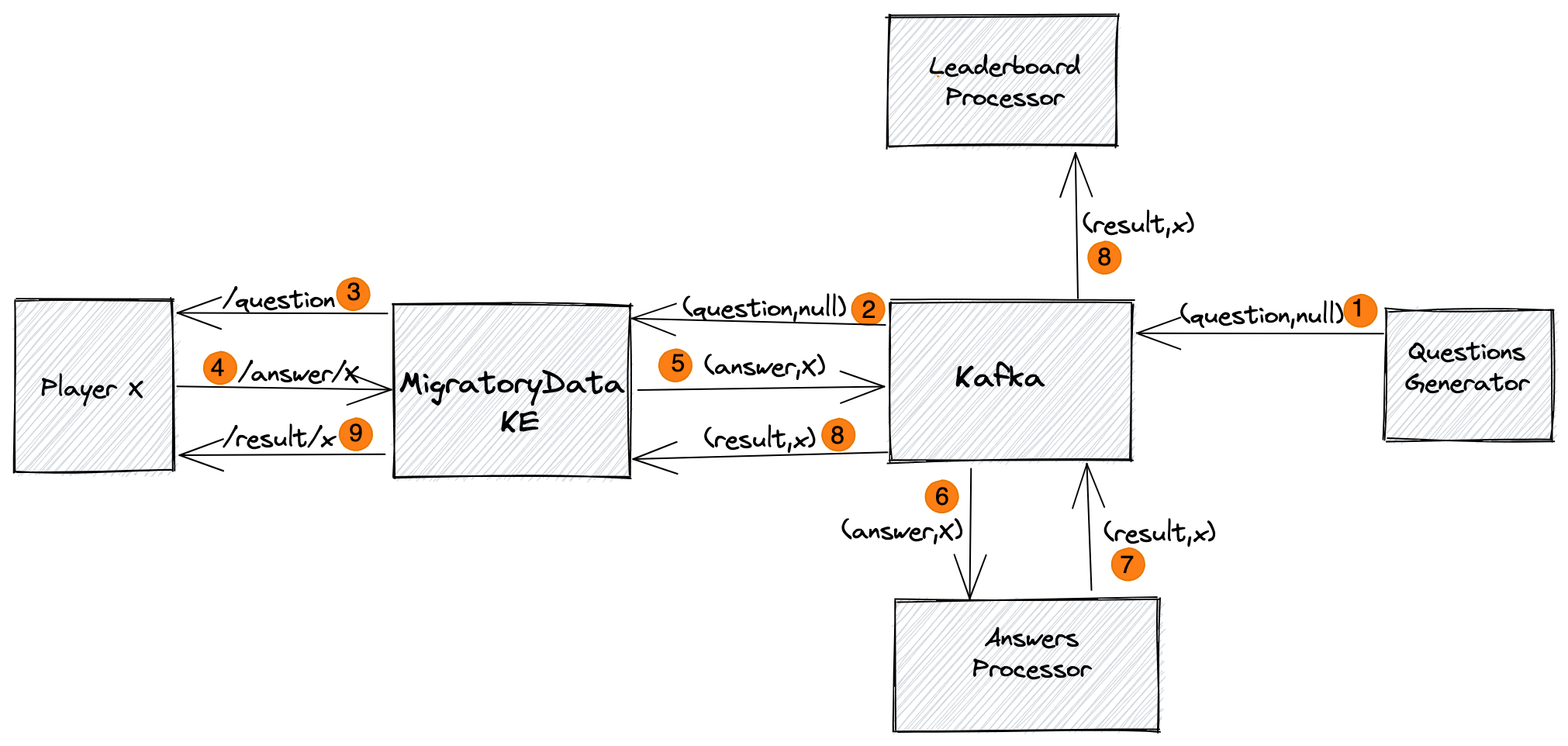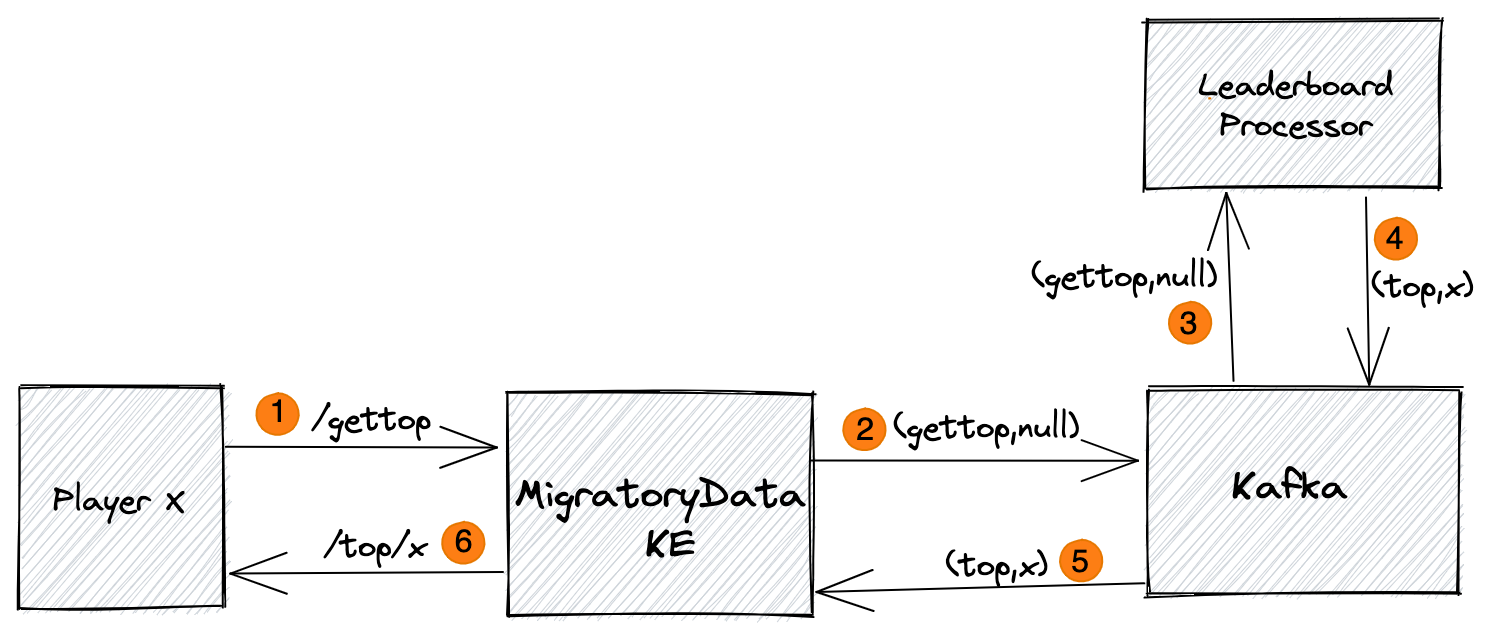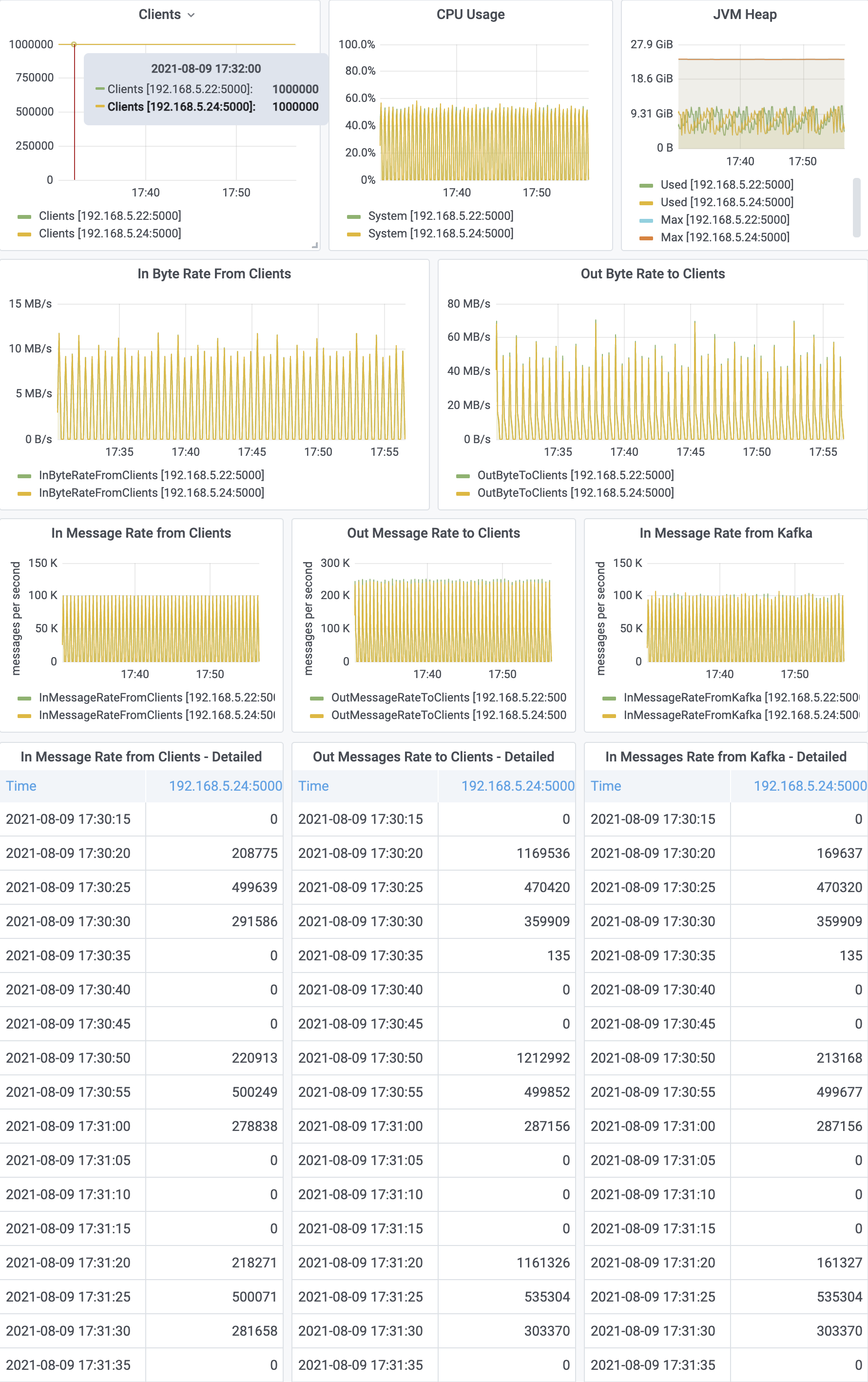In this post we show how to create an interactive gamification feature that scales. We demonstrate that it is feasible and cost effective to build such kind of interactive features using MigratoryData and its Kafka Native Add-on to engage in realtime with millions of users. To this end, we perform a benchmark study that demonstrates that MigratoryData scales vertically up to one million concurrent users on a single instance in the given scenario, and scales horizontally in a linear fashion, with a shared-nothing clustering architecture, by simply adding more instances to the cluster.
Realtime Interactions with Millions of Sports Fans
MigratoryData is a publish/subscribe web messaging solution with over a decade experience in delivering realtime data to large audiences across various industries, including sports. In a previous article, we explained how one of our customers has been using MigratoryData to deliver realtime scores and odds to more than 100 millions sports fans, of which more than one million are simultaneous. As soon as a live score or odd is published to the sports platform on a certain subject, MigratoryData broadcasts it in realtime over WebSockets to the fans subscribed to that subject. So this is a subscribers-dominated use case.
In this post, we’ll look at a different use case for sports involving both realtime data and a large number of sports fans, but where subscribers and publishers are balanced. We’ll look at a use case where sports fans not only receive realtime data from the sports platform, but also send back realtime data to the sports platform. We take a look at the OTT platform Disney+ Hotstar and its interactive game Watch’N Play. During the last edition of the World Cricket Cup, the OTT platform Disney+ Hotstar counted 25.3 million simultaneous viewers, a world record in terms of audience. The OTT platform has been using gamification to engage with the large number of cricket fans in India using the Watch’N Play interactive game where viewers of a live cricket match can answer in realtime to live questions about what happens on the next ball to win points and redeem prizes.
Watch’N Play has been built around Kafka. We were curious to see how MigratoryData with its Kafka Native Add-on — which is an off-the-shelf Kafka-native solution for realtime web messaging at scale — would address such massive scalability needs. Therefore, we’ve built a live demo inspired by Watch’NPlay and performed a benchmark study for this use case as detailed below.
Live Gamification Demo
We’ve built a live gamification demo asking every 20 seconds a live question with a 10-second deadline. Therefore, a player of the demo has 10 seconds to answer to a live question to win points. The demo also displays a leaderboard with the ten highest scoring players. A number of ten bot players are permanently connected to the demo, answering randomly to the live questions to generate some activity.

The demo consists of the following components besides MigratoryData and Apache Kafka:
| Component Name | Description |
|---|---|
| UI | A realtime web application (MigratoryData subscriber and publisher) |
| Questions Generator |
Generate live questions (Kafka producer) |
| Answers Processor |
Process the answer received from a player (Kafka consumer) and publishes back the new points won by that player (Kafka producer) |
| Leaderboard Processor |
Update the leaderboard with the new points won by a player (Kafka consumer), get a leaderboard request (Kafka consumer), and publish the current leaderboard following a request (Kafka producer) |
MigratoryData should be configured to consume the Kafka topics question, result, and top that are explained
below. Thus, the configuration file integrations/kafka/consumer.properties of MigratoryData should contain the
following configuration:
topics = question,result,top
The UI of the demo consists of two views: a Play View and a Leaderboard View.
Play View
The following MigratoryData subjects and Kafka topics and keys are used to model the realtime interactions of the Play View:
| Kafka (Topic, Key) | MigratoryData Subject | Description |
|---|---|---|
(question, null) |
/question |
Used by the Questions Generator to generate live questions |
(answer, x) |
/answer/x |
Used by the Player with the id x to deliver the answer to a live question |
(result, x) |
/result/x |
Used by the Answers Processor to let the Player with the id x, as well as the Leaderboard Processor, know how many points the Player won after having answered to a live question |
The realtime information flow between the components of the demo using these subjects, topics, and keys as depicted in the following diagram:

A Player x that opens the Play View connects to MigratoryData using a persistent WebSocket connection
and subscribes to the subjects /question and /result/x. The Questions Generator generates a live question every 20
seconds by publishing a message on the topic question ❶. As MigratoryData is configured to consume the
topic question, it will get each live question ❷ and will stream it to the Player on the subject /question ❸, to
which the Player is subscribed to. The Player has up to 10 seconds to answer to the live question by publishing a message on
the subject /answer/x to MigratoryData ❹, which in turn sends it to Kafka on the topic answer with the key x ❺.
The Answers Processor consumes the message from the topic answer ❻, checks if the answer provided by the Player x is
correct, and sends back the points won by the Player by publishing to Kafka a message on the topic result with the key
x ❼. This message will be consumed by the Leaderboard Processor to update its list of top Players ❽. The message is
also consumed by MigratoryData ❽, which is configured to consume the topic result, that in turn sends it to the
Player on the subject /result/x ❾, to which the Player is subscribed to.
Leaderboard View
The following MigratoryData subjects and Kafka topics and keys are used to model the realtime interactions of the Leaderboard View:
| Kafka (Topic, Key) | MigratoryData Subject | Description |
|---|---|---|
(gettop, null) |
/gettop |
Used by a Player to request the leaderboard |
(top, x) |
/top/x |
Used by the Leaderboard Processor to let the Player with the id x, which requested the leaderboard, know what is the current list of the top ten players |
The realtime information flow between the components of the demo using these subjects, topics, and keys as depicted in the following diagram:

A Player x that opens the Leaderboard View connects to MigratoryData using a persistent WebSocket connection,
subscribes to the subject /top/x, and publishes a request message containing its id x on the subject /gettop to
get the updated list of the top ten Players ❶. MigratoryData sends the request message to Kafka on the
topic gettop without using a key ❷, which is consumed by the Leaderbord Processor ❸. Once the request received, the
Leaderboard Processor sends back a response message with the current leaderboard on the topic top, with the key x ❹.
As MigratoryData is configured to consume the topic top, it gets the response message ❺, and pushes it to
the Player on the subject /top/x ❻, to which the Player is subscribed to.
The source code of the demo is available on GitHub. The folder frontend contains the
source code of the UI. The folder backend contains the source code of the Leaderboard Processor, Answers Processor, and
Questions Generator.
Vertical Scalability
We’ve performed a benchmark test that demonstrates that a single instance of MigratoryData with Kafka Native Addon enabled running on a commodity server with 2 x Intel Xeon E5-2670 CPU and 64 GB RAM can handle 1 million concurrent players in the given gamification scenario.
Benchmark Setup
A Players Simulator running on the Test Machine 3 opens one million WebSocket connections to a single instance of MigratoryData running on the Test Machine 2. Kafka, Answers Processor, and Questions Generator run on the same Test Machine 1.

Benchmark Scenario
The benchmark covers the realtime interactions of the Play View which represents the main activity of the gamification feature. The activity produced by the Leaderboad View typically involves a small number of concurrent Players and so has been ignored by our benchmark.
Therefore, we use the following benchmark scenario:
- each player
iof the one million players subscribes to the subjects/questionand/result/i - all players receive every 20 seconds a live question as a JSON object of under 256 characters, containing the id of the question, the question itself, the answer options, the number of points to win (the demo project includes the list of the questions from which a live question is picked randomly)
- the player
iparses the JSON object containing the live question, and sends back after a random number of seconds between 0 and 10 seconds (remember, each question has a 10-second deadline) an answer as a JSON object, which contains the id of the live question and the option selected randomly from the received answer options - the player
igets the points it won on the last question along the subject/result/i
Benchmark Results
MigratoryData ran on the Machine 2 with the IP address 192.168.5.22 and accepted the connections from the Players
Simulator on the port 5000. We’ve monitored MigratoryData using Prometheus and Grafana. From the Grafana dashboard
below we can see that there are 1 million concurrent WebSocket connections which remain persistent during the test time.
We also see from the dashboard that all messages are processed until the next live question is proposed. We also observe that no message is lost even if MigratoryData is configured to use Standard Message Delivery rather than
Guaranteed Message Delivery. More concretely, we can see 1,000,001 messages from Kafka to MigratoryData during a
round when a question is processed: 1 message is the live question and 1,000,000 messages are the result messages sent
for each player. Also, we can see 1,000,000 messages from the Players Simulator to MigratoryData which represent the
answer messages the players send following a live question. Finally, we see 2,000,000 messages from MigratoryData to
the Players Simulator which represent the result and the live question messages for each of the one million players.
Note that if the result message is specific for each player, the question is the same for all players. Therefore, we can
see that the 1 message received from Kafka as a live question is multiplexed by MigratoryData to one million messages
to the clients.

Linear Horizontal Scalability
MigratoryData can be clustered to scale horizontally. Moreover, MigratoryData does not share any user state across the cluster. Each instance of MigratoryData running in the cluster is independent of the other instances. Therefore MigratoryData scales linearly.
The benchmark result above has shown that for the given scenario, a cluster of one instance of MigratoryData running on a machine with 2 x Intel Xeon E5-2670 CPU and 64 GB RAM can handle one million concurrent users. To exemplify the linear scalability discussed above, we show that by adding a new instance of MigratoryData to the cluster, running on a machine with the same hardware, the cluster capacity increases to 2 million concurrent users.
Benchmark Setup
A cluster of MigratoryData with two instances are deployed on the Test Machine 2 and respectively Test Machine 4. A
Players Simulator A running on the Test Machine 3 opens one million WebSocket connections to the first instance of
the cluster, and a Players Simulator B running on the Test Machine 5 opens one million WebSocket connections to the
second instance of the cluster. Kafka, Answers Processor, and Questions Generator run on the same Test Machine 1.

Benchmark Scenario
We use basically the same scenario as described above, with a change to the subjects and topics to limit the communication between Kafka and a MigratoryData instance only to the messages related to the clients of that MigratoryData instance:
- each player
iof the Players SimulatorAsubscribes to the subjects/questionand/resultA/i - each player
jof the Players SimulatorBsubscribes to the subjects/questionand/resultB/i - all players receive every 20 seconds a live question on the subject
/question - the player
iof the Players SimulatorAand the playerjof the the Players SimulatorBrespond on the subjects/answerA/iand respectively/answerB/jto each live question after a random number of seconds between 0 and 10 seconds (remember, each question has a 10-second deadline) - the player
iof the Players SimulatorAand the playerjof the the Players SimulatorBget the points they won on the last question along the subjects/resultA/iand respectively/resultB/j
Benchmark Results
An instance of MigratoryData ran on the Machine 2 with the IP address 192.168.5.22 and accepted one million
concurrent WebSocket connections on the port 5000 from an instance of the Players Simulator. A second instance of
MigratoryData ran on the Machine 4 with the IP address 192.168.5.24 and accepted one million concurrent WebSocket
connections on the port 5000 from another instance of the Players Simulator. From the Grafana dashboard below, we can
see that there are 2 million concurrent WebSocket connections which remain persistent during the test time. We can count
the number of messages as explained in the Vertical Scalability section above and see that all messages are processed
until the next live question is proposed with no message loss.

Conclusion
In this post we have seen how to use MigratoryData and Apache Kafka to build a realtime gamification feature at scale with a focus on sports. Of course, a realtime gamification feature, and more generally a feature involving realtime interaction with lots of users, can apply to other fields. Instead of a live sports match, we can have a live video produced by a content creator, a conference or class broadcasted live, a live audio-chat, and in general any live content either if it is video, audio, or even text which has many users and needs realtime engagement with them.
We’ve also seen that a single instance of MigratoryData running on a commodity server with 2 x Intel Xeon E5-2670 CPU and 64 GB RAM can handle one million concurrent users in the given scenario. Also, we’ve explained the linear scalability of MigratoryData and exemplified it: we’ve increased the cluster capacity with another million of concurrent users by adding a new instance to the cluster. Therefore, assuming the impact on Apache Kafka remains acceptable as the number of cluster members increases, it is safe to extrapolate and assume that the cluster capacity can be increased to many millions of concurrent users in the given gamification scenario, where each cluster member handles one million concurrent users.
Should your application need a feature to interact in realtime with your audience, please contact us. We look forward to learning about your application requirements.
